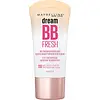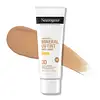What's inside
What's inside
 Key Ingredients
Key Ingredients

 Benefits
Benefits

 Concerns
Concerns

 Ingredients Side-by-side
Ingredients Side-by-side

Titanium Dioxide
Cosmetic ColorantWater
Skin ConditioningEthylhexyl Palmitate
EmollientGlycerin
HumectantOctyldodecanol
EmollientSilica
AbrasivePentylene Glycol
Skin ConditioningOctyldodecyl Xyloside
EmulsifyingPhenoxyethanol
PreservativeSodium Acrylate/Sodium Acryloyldimethyl Taurate Copolymer
Emulsion StabilisingHydrogenated Lecithin
EmulsifyingIsohexadecane
EmollientHydroxyethyl Acrylate/Sodium Acryloyldimethyl Taurate Copolymer
Emulsion StabilisingPEG-30 Dipolyhydroxystearate
EmulsifyingSodium Dehydroacetate
PreservativePentaerythrityl Tetra-Di-T-Butyl Hydroxyhydrocinnamate
AntioxidantCaprylyl Glycol
EmollientDisodium EDTA
Citric Acid
BufferingPolysorbate 80
EmulsifyingPotassium Sorbate
PreservativePropylene Glycol
HumectantChamomilla Recutita Flower Extract
MaskingAloe Barbadensis Leaf Extract
EmollientIron Oxides
Titanium Dioxide, Water, Ethylhexyl Palmitate, Glycerin, Octyldodecanol, Silica, Pentylene Glycol, Octyldodecyl Xyloside, Phenoxyethanol, Sodium Acrylate/Sodium Acryloyldimethyl Taurate Copolymer, Hydrogenated Lecithin, Isohexadecane, Hydroxyethyl Acrylate/Sodium Acryloyldimethyl Taurate Copolymer, PEG-30 Dipolyhydroxystearate, Sodium Dehydroacetate, Pentaerythrityl Tetra-Di-T-Butyl Hydroxyhydrocinnamate, Caprylyl Glycol, Disodium EDTA, Citric Acid, Polysorbate 80, Potassium Sorbate, Propylene Glycol, Chamomilla Recutita Flower Extract, Aloe Barbadensis Leaf Extract, Iron Oxides
Titanium Dioxide
Cosmetic ColorantZinc Oxide
Cosmetic ColorantWater
Skin ConditioningIsohexadecane
EmollientDicaprylyl Carbonate
EmollientDimethicone
EmollientIsopropyl Palmitate
EmollientIsononyl Isononanoate
EmollientCetyl PEG/PPG-10/1 Dimethicone
EmulsifyingC12-15 Alkyl Benzoate
AntimicrobialSodium Chloride
MaskingPolyhydroxystearic Acid
EmulsifyingTocopheryl Acetate
AntioxidantTriethoxycaprylylsilane
Sorbitan Sesquioleate
EmulsifyingPhenoxyethanol
PreservativeEthylhexylglycerin
Skin ConditioningDimethiconol
EmollientAluminum Hydroxide
EmollientDimethicone Crosspolymer
Emulsion StabilisingStearic Acid
CleansingXanthan Gum
EmulsifyingIron Oxides
Titanium Dioxide, Zinc Oxide, Water, Isohexadecane, Dicaprylyl Carbonate, Dimethicone, Isopropyl Palmitate, Isononyl Isononanoate, Cetyl PEG/PPG-10/1 Dimethicone, C12-15 Alkyl Benzoate, Sodium Chloride, Polyhydroxystearic Acid, Tocopheryl Acetate, Triethoxycaprylylsilane, Sorbitan Sesquioleate, Phenoxyethanol, Ethylhexylglycerin, Dimethiconol, Aluminum Hydroxide, Dimethicone Crosspolymer, Stearic Acid, Xanthan Gum, Iron Oxides
 Reviews
Reviews

Ingredients Explained
These ingredients are found in both products.
Ingredients higher up in an ingredient list are typically present in a larger amount.
Isohexadecane is added to enhance texture, emulsify, and to help cleanse. It is an isoparrafin. It is a component of petrolatum.
Due to its large size, Isohexadecane is not absorbed by the skin. Instead, it sits on top and acts as an emollient. Emollients help keep your skin soft and smooth by trapping moisture within.
Isohexadecane is often used in products designed to help oily skin. It is lightweight and non-greasy while helping to moisturize. When mixed with silicones, it gives a product a silky feel.
Learn more about IsohexadecanePhenoxyethanol is a preservative that has germicide, antimicrobial, and aromatic properties. Studies show that phenoxyethanol can prevent microbial growth. By itself, it has a scent that is similar to that of a rose.
It's often used in formulations along with Caprylyl Glycol to preserve the shelf life of products.
Titanium dioxide is a mineral UV filter widely used in sunscreens and cosmetics.
It is one of only two UV filters officially classified as “mineral” by regulatory agencies, the other being zinc oxide.
Titanium dioxide provides broad-spectrum protection mostly in the UVB and UVAII range, with some protection in the UVAI range.
While its UVA protection isn’t as strong as zinc oxide’s, the difference is minor.
A common myth is that mineral UV filters reflect UV light. However, modern research shows titanium dioxide absorbs UV radiation like chemical filters (~95% absorption & 5% reflection).
Thanks to its non-irritating nature, titanium dioxide is suitable for sensitive, acne-prone, or redness-prone skin. It is unlikely to cause "eye sting" like other sunscreen ingredients.
A major drawback of this ingredient is its white cast and thick texture. This is why mineral sunscreens often leave a white cast and are less cosmetically elegant than chemical/hybrid sunscreens.
To improve white cast and spreadability, micronized or nano-sized titanium dioxide is often used.
There are ongoing concerns surrounding nano-titanium oxide's impact on marine ecosystems.
There is no conclusive evidence that any form of titanium oxide (or any other sunscreen ingredients) will cause harm to marine ecosystems or coral reefs. The science is still developing but many consumers are keeping a close eye on this issue.
Please note, many destinations have reef-safety sunscreen rules. For instance, the U.S. Virgin Islands advises all visitors to use non-nano mineral sunscreens.
Nano mineral sunscreens once raised safety concerns about absorption into skin.
Extensive research has shown that they do not penetrate healthy or damaged skin; they remain safely on the surface and the top layer of dead skin (stratum corneum).
You'll likely find titanium dioxide bundled with alumina, silica, or dimethicone. These ingredients help make titanium dioxide highly photostable; this prevents it from interacting with other formula components under UV light.
Learn more about Titanium DioxideWater. It's the most common cosmetic ingredient of all. You'll usually see it at the top of ingredient lists, meaning that it makes up the largest part of the product.
So why is it so popular? Water most often acts as a solvent - this means that it helps dissolve other ingredients into the formulation.
You'll also recognize water as that liquid we all need to stay alive. If you see this, drink a glass of water. Stay hydrated!
Learn more about WaterThis ingredient is a combination of red, black, and yellow iron oxide pigments. This combination of colors is usually found in foundation, because it results in a "skin" color.